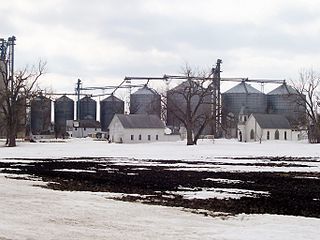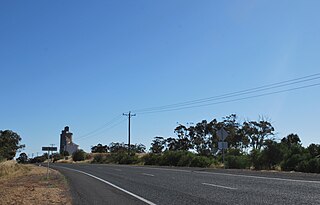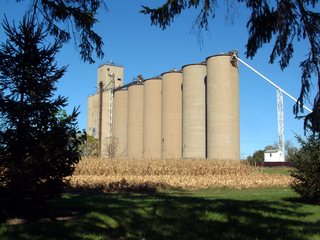
Shea was a small village in Jefferson County, Nebraska, [1] located about four miles west of the town of Diller.

Shea was a small village in Jefferson County, Nebraska, [1] located about four miles west of the town of Diller.
Shea began as a railroad siding and grain elevator that was informally called Fitzgerald's Siding. In 1901, the Burlington Railroad inaugurated its St. Louis to Denver route, necessitating the laying of 800 feet of new track at the site. [2] The name Fitzgerald's Siding was deemed too long, so as a convenience to the railroad the name was changed to Shea, honoring the pioneer John Shea, who had settled in the area. [3] [4]
In 1905, the landowner Otto Willems constructed a brick building at Shea and partnered with son-in-law August Kunter to establish a general mercantile business for the surrounding farmers. [5] [6] Willems & Kunter was Shea's first business establishment.
Otto Willems' widow, Anna, hired civil engineer W. W. Watson in 1907 to plat a town site, resulting in four square blocks with 13 lots to be used for business, the rest for residential. [7] Streets included Main Street, Lawrence Street, West Street, and Railway Street.
At various times during its heyday in the 1910s and 1920s, Shea had a mercantile business, a barber shop, a grocery store, a post office, a blacksmith shop, a grain elevator, stockyards, a community hall, and a railroad depot with occasional passenger service. [8] [9] Shea's population most likely never exceeded 50 residents.
Shea did not make it through the Great Depression. By 1941, the once-thriving little village had reverted to just a grain elevator with a residence or two. [9]

Lake Crystal is a city in Blue Earth County, Minnesota, United States, established in 1869. The population was 2,539 at the 2020 census. It is part of the Mankato-North Mankato Metropolitan Statistical Area.

Tenney is an unincorporated community and former city in section 28 of Campbell Township, Wilkin County, Minnesota, United States. A post office was established there in 1887, and Tenney was incorporated as a city on November 30, 1901. The population was five at the 2010 census, tying Tenney with Funkley as Minnesota's least populous community. It is part of the Wahpeton, ND–MN Micropolitan Statistical Area. The only portion of Tenney that is still active is a grain elevator along the tracks on the south side of town.

Hysham is a town in and the county seat of Treasure County, Montana, United States. The population was 276 at the 2020 census.

Abie is a village in Butler County, Nebraska, United States. The population was 69 at the 2010 census.

Fairbury is a city and county seat of Jefferson County, Nebraska, United States. The population was 3,942 at the 2010 census.

Sintaluta is a town in Saskatchewan, Canada. The population of Sintaluta is 124 people according to the 2021 Census of Population. The town is located about 85 km east of Regina. The town is on the north side of the Trans-Canada Highway.

The Wiscasset, Waterville and Farmington Railway is a 2 ft narrow gauge railway. The line was operated as a for-profit company from 1895 until 1933 between the Maine towns of Wiscasset, Albion, and Winslow, but was abandoned in 1936. Today, about three miles (4.8 km) of the track in the town of Alna has been rebuilt and is operated by the non-profit Wiscasset, Waterville and Farmington Railway Museum as a heritage railroad offering passenger excursion trains and hauling occasional cargo.

Antwerp is a locality in Victoria, Australia on the Dimboola – Rainbow Road, in the Shire of Hindmarsh, 14 kilometres (8.7 mi) north of Dimboola and 356 kilometres (221 mi) north-west of Melbourne. The Wimmera River passes 500 metres (550 yd) west of the locality. The population at the 2016 census was 63.

Tab is an unincorporated community in Warren County, Indiana, United States. Its only current business or service is the Tabor Grain Company which operates the town's grain elevators. The present population of Tab is 36 as of the 2020 census
The Macomb and Western Illinois Railway was chartered on October 26, 1901. The railroad was built south along Johnson Street in Macomb, Illinois, to nearby Industry and Littleton by local financier Charles V. Chandler. It was open for service on January 1, 1904. It ran for about twenty-five years.
The Hagerstown and Frederick Railway, now defunct, was an American railroad of central Maryland built in the 19th and 20th centuries.

Girvin is a former village of 20 people in Saskatchewan, Canada. It is located midway between Regina and Saskatoon on Highway 11 between the towns of Davidson and Craik. The village was formally dissolved in 2005; its remaining population is now counted as part of the rural municipality of Arm River.

The St. Louis Mercantile Library, founded in 1846 in downtown St. Louis, Missouri, was originally established as a membership library, and is the oldest extant library west of the Mississippi River. Since 1998 the library has been housed at the University of Missouri-St. Louis as a Special Collections library within the Thomas Jefferson Library. The majority of library materials can be assigned to one of four categories: the General (Core) Collection, the John W. Barriger Railroad Library, the Herman T. Pott National Inland Waterways Library, or the Art Museum. The collections of the St. Louis Mercantile Library have been named a City Landmark by the city of St. Louis, Mo., due to the cultural significance of the library.
Autwine is a ghost town in Kay County, Oklahoma, United States, formerly known as Pierceton and Virginia City. The town was named for a prominent citizen and leader of the Ponca Nation named Antoine Roy. It had a post office as Pierceton from May 26, 1894, and as Autwine from March 5, 1903, until June 30, 1922.

Berea is an unincorporated community and census-designated place in Box Butte County, in the northwestern part of the state of Nebraska in the Midwestern United States. It had a population of 41 at the 2010 census.

Tamora is a census-designated place in Seward County, Nebraska, United States. The community presently consists of a large grain elevator complex and a small residential district, with a population of about 70.
Winnifred is a hamlet in Alberta, Canada that is under the jurisdiction of the County of Forty Mile No. 8. It is approximately 50 km (31 mi) southwest of the City of Medicine Hat and 14 km (8.7 mi) east of the Town of Bow Island.
Saltillo was an unincorporated community in Lancaster County, Nebraska, United States.

The John Wesley and Grace Shafer Warrick House, also known as the John W. Warrick Sr. House, is a house in the southern part of the city of Meadow Grove, in the northeastern part of the state of Nebraska, in the Midwestern United States. The house was built in the Queen Anne style in 1903 by a prominent Meadow Grove businessman, who made some additions and alterations in the 1920s. The builder, and subsequently his descendants, continuously occupied it into at least the late 20th century.

George Armour was a Scottish American businessman and philanthropist known for his contributions to the global distribution process for commodities. He was credited with developing the grain elevator system, establishing grain trading standards as director and president of the Chicago Board of Trade (CBT), founding the Chicago, Burlington and Quincy Railroad (CBQ), Commercial Club of Chicago, YMCA of Chicago, Merchants' Loan & Trust Company (MLTC), the precursor to Continental Illinois, and the Chicago Academy of Fine Arts which later became the School of the Art Institute of Chicago and Art Institute of Chicago. He served as a director of several notable companies during his career.